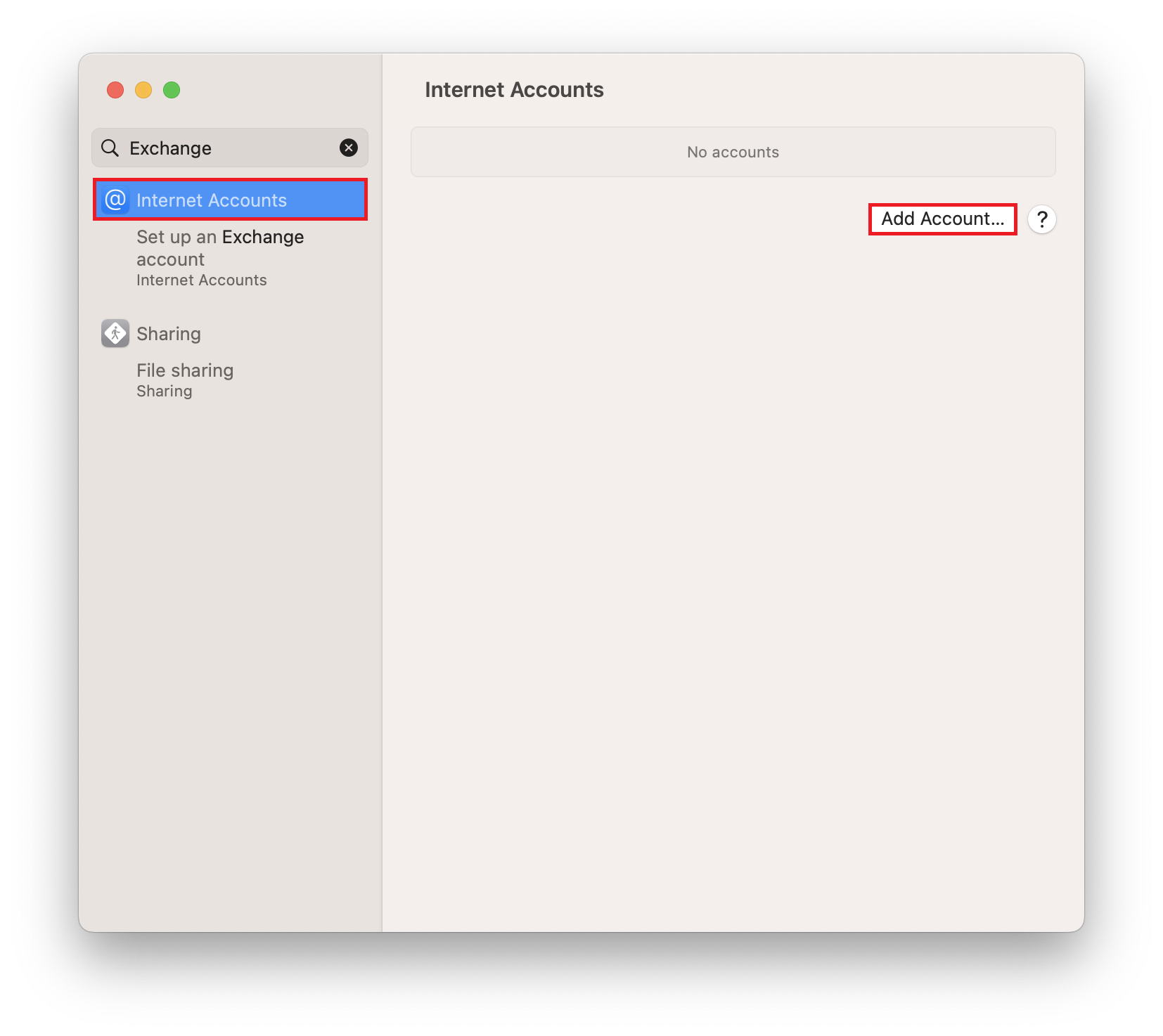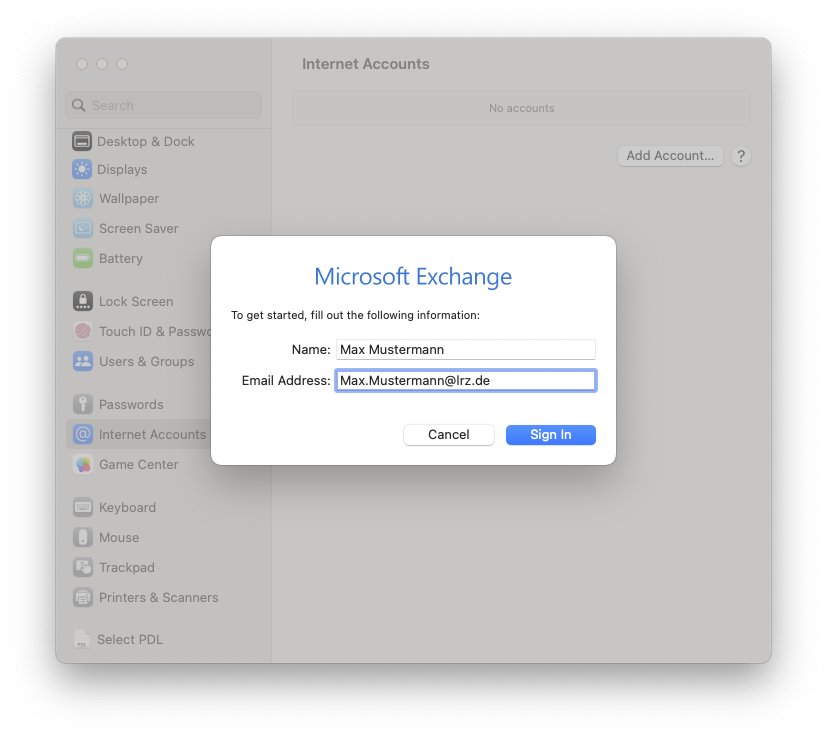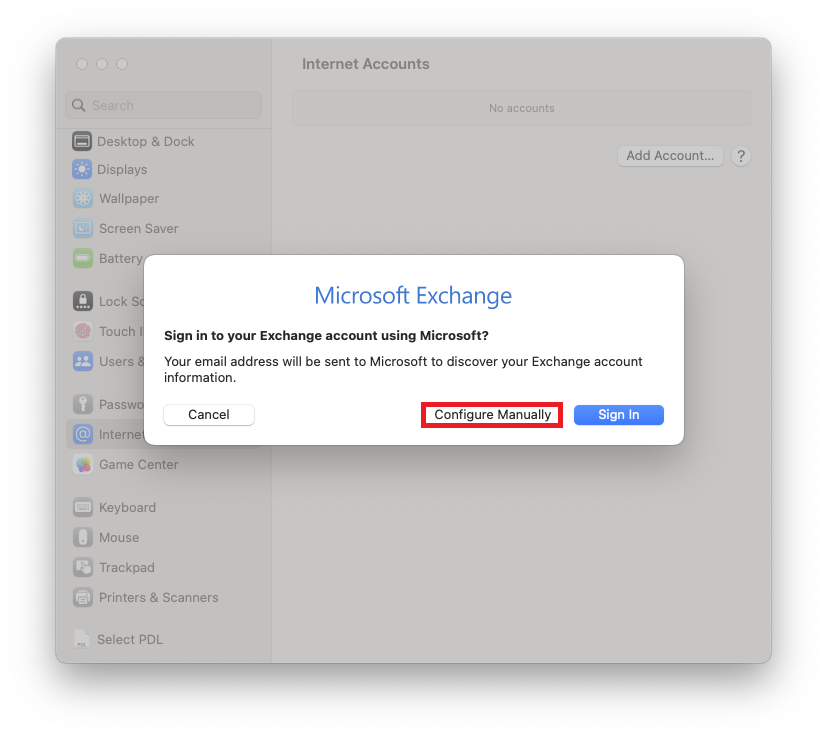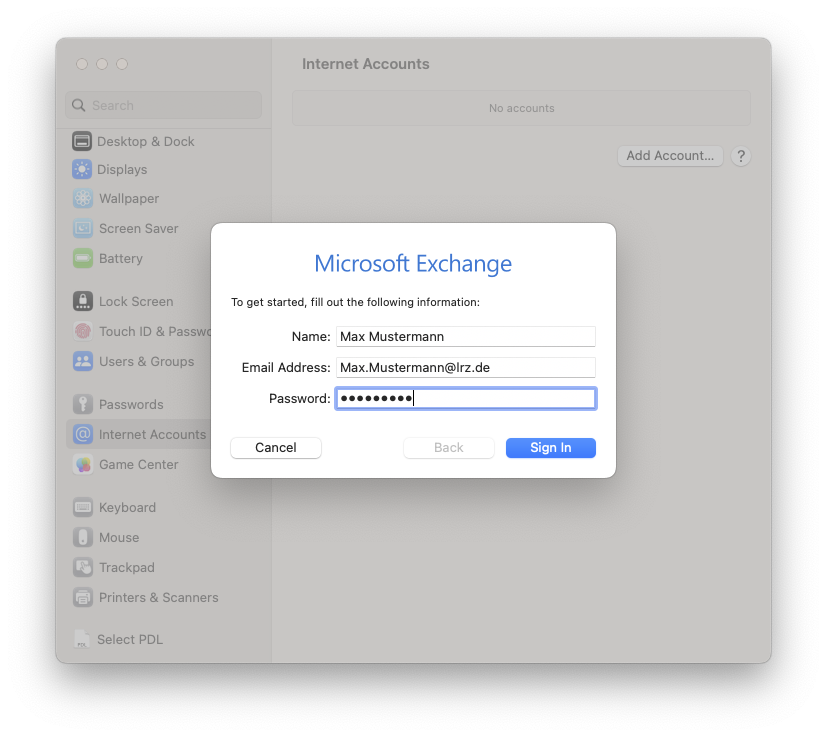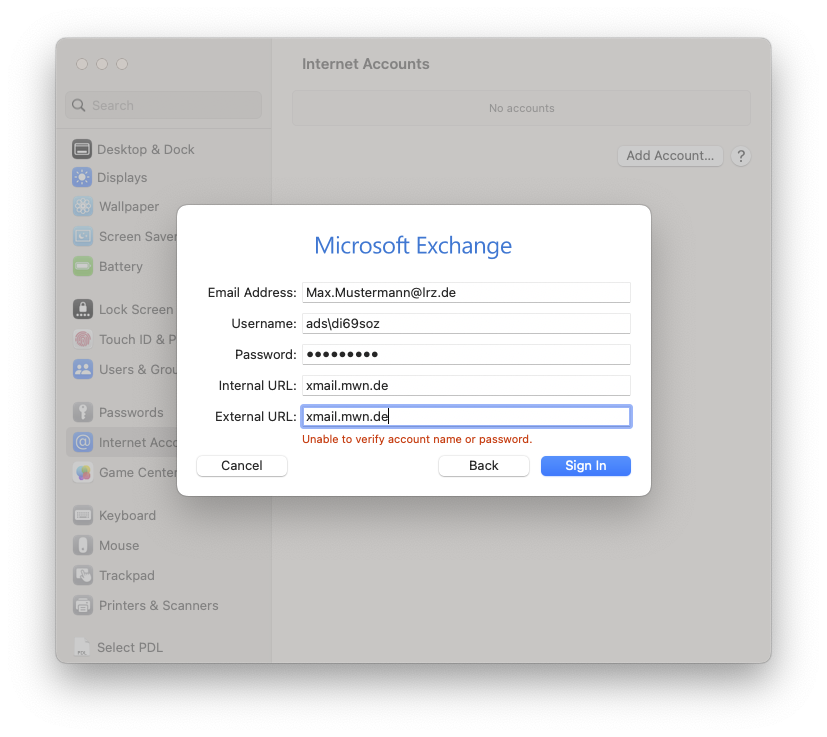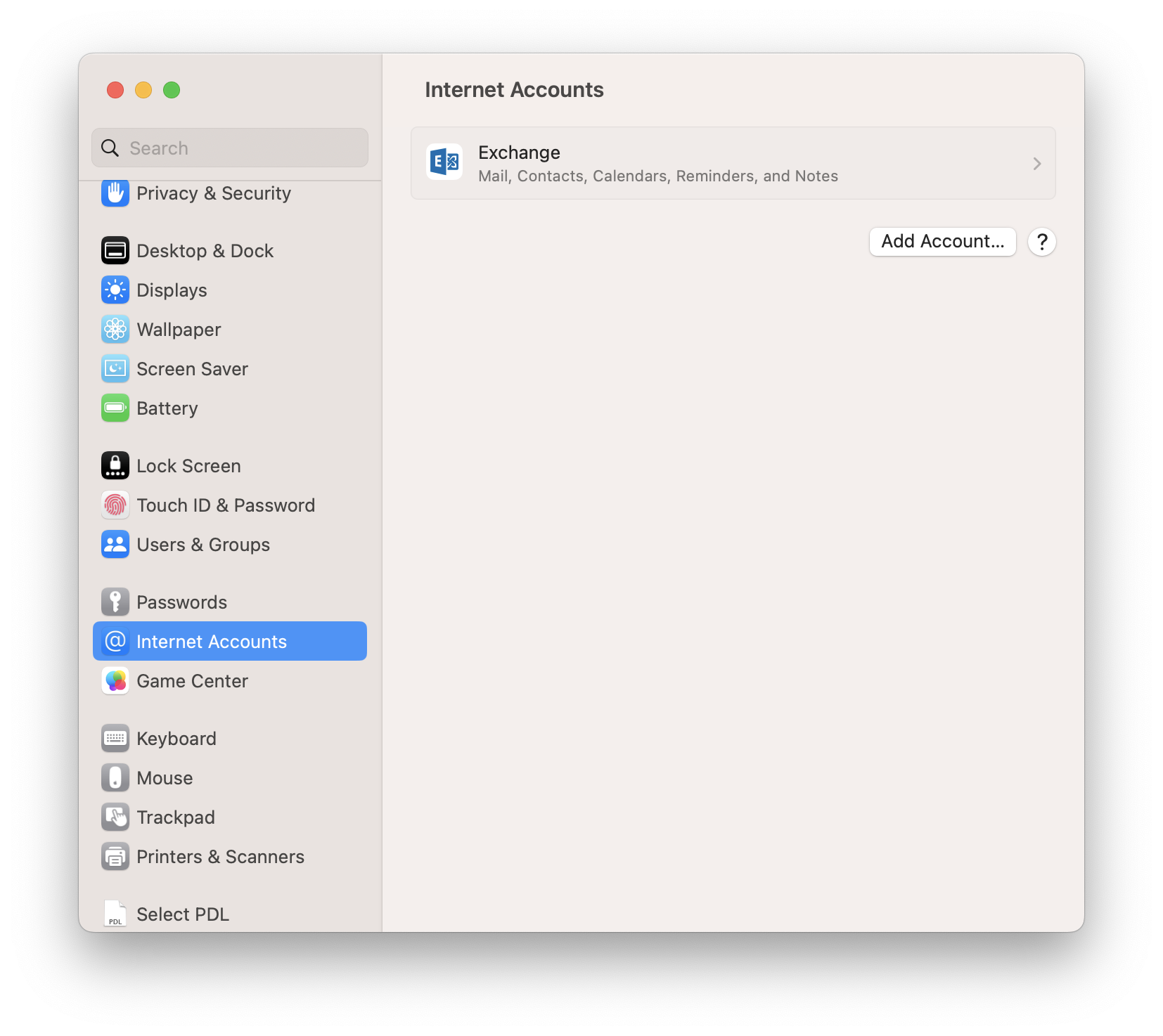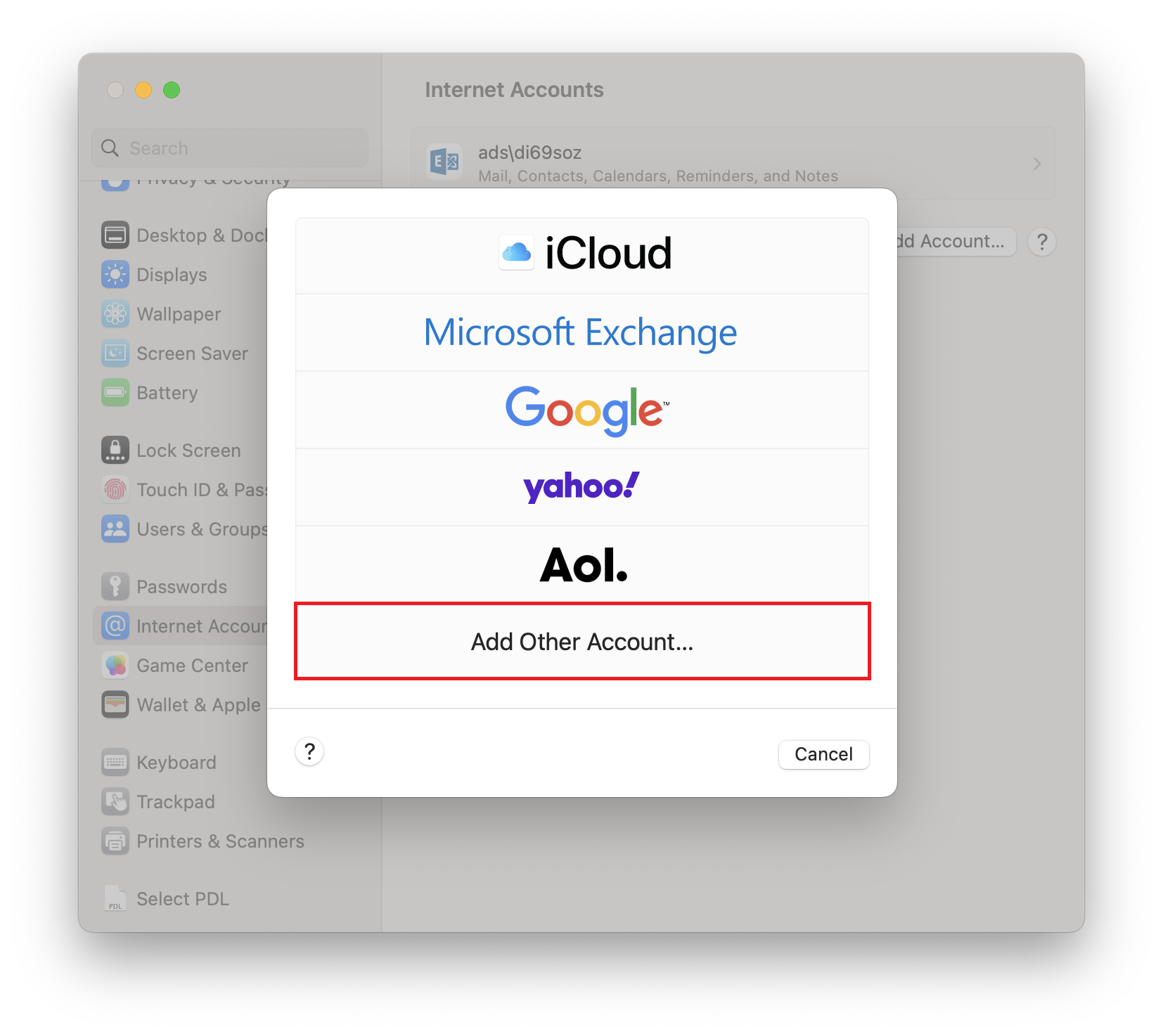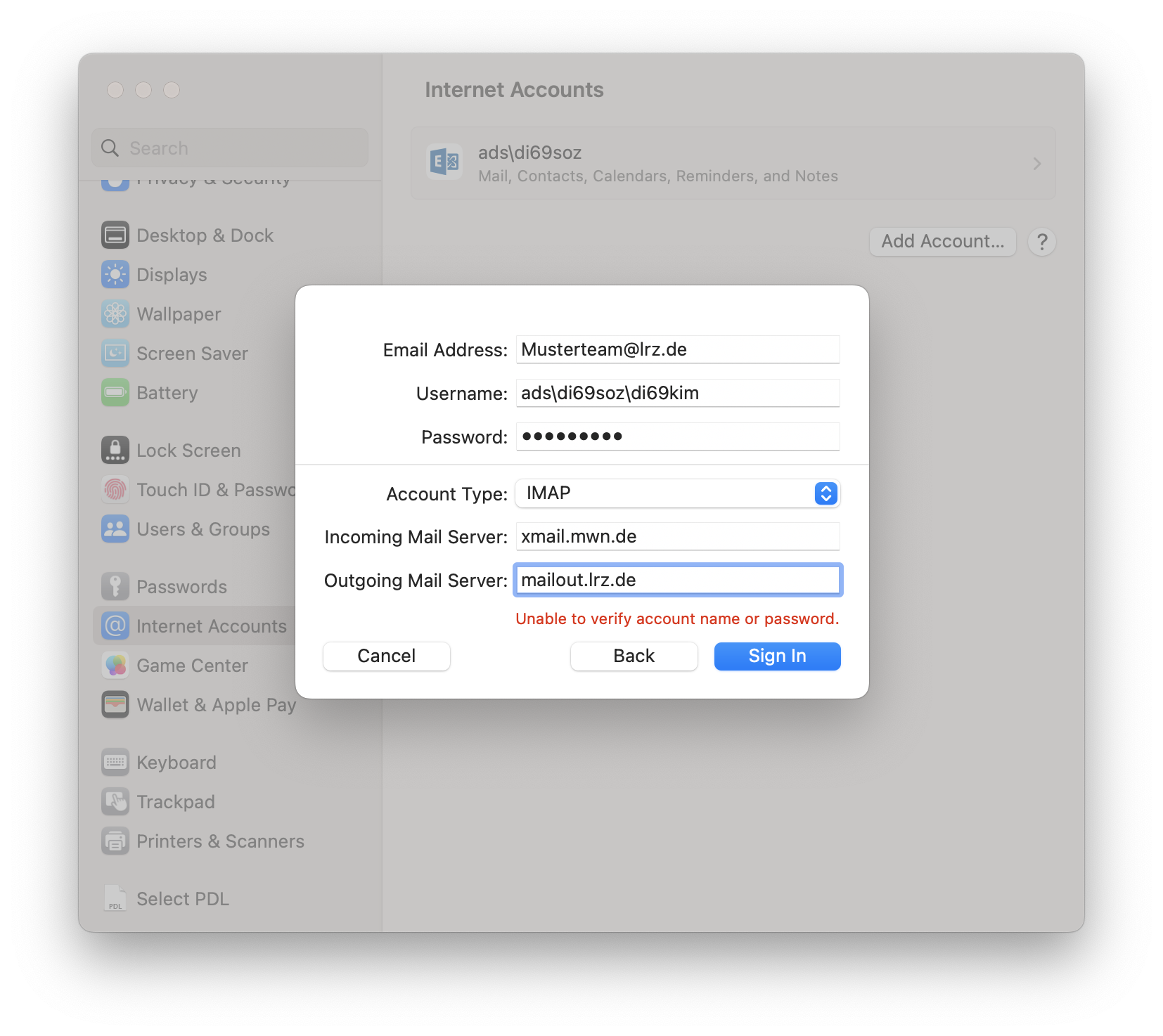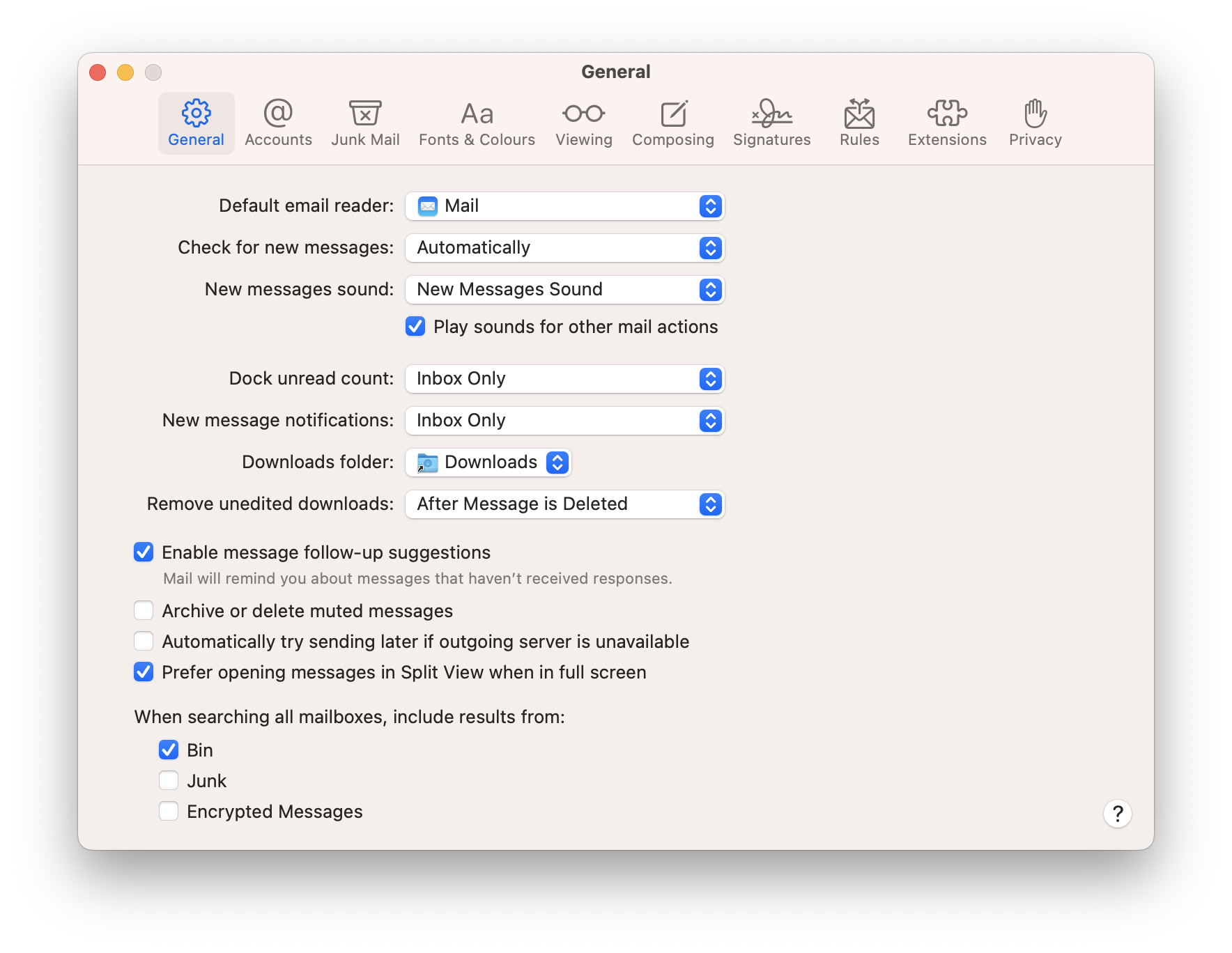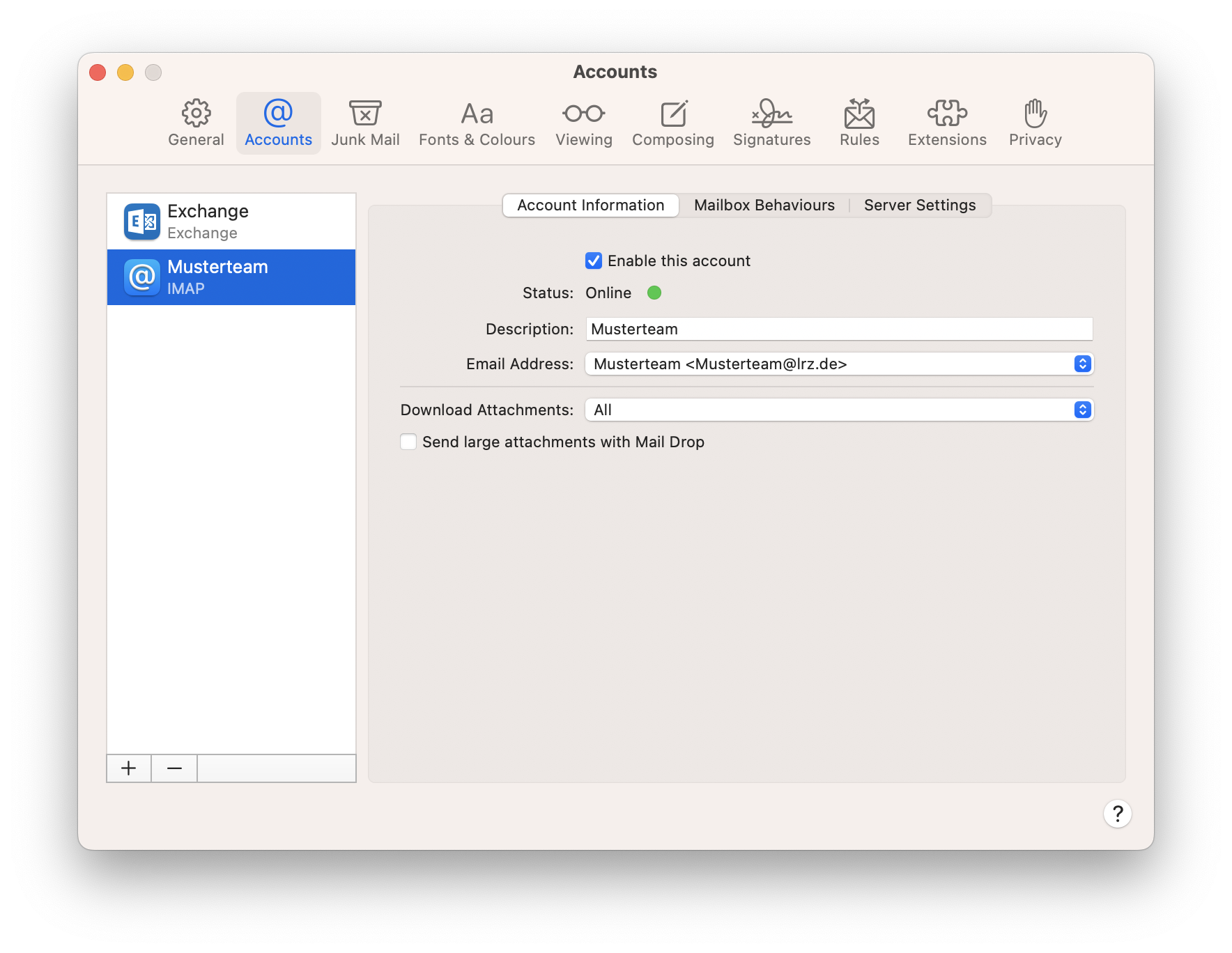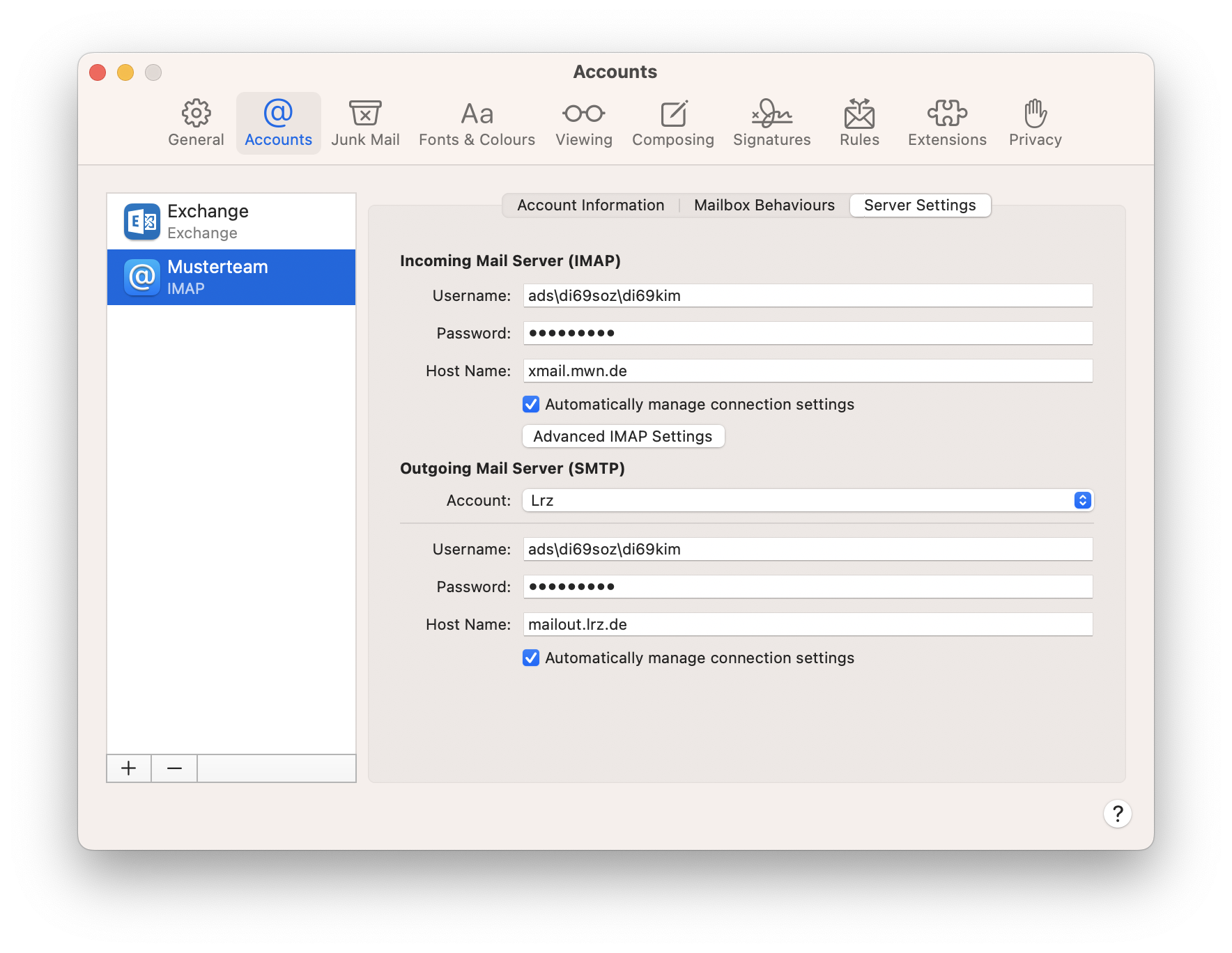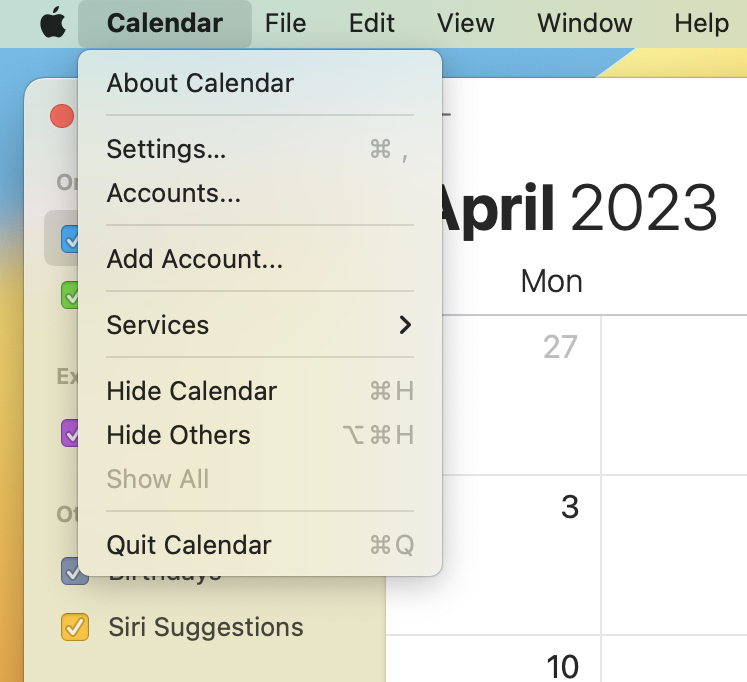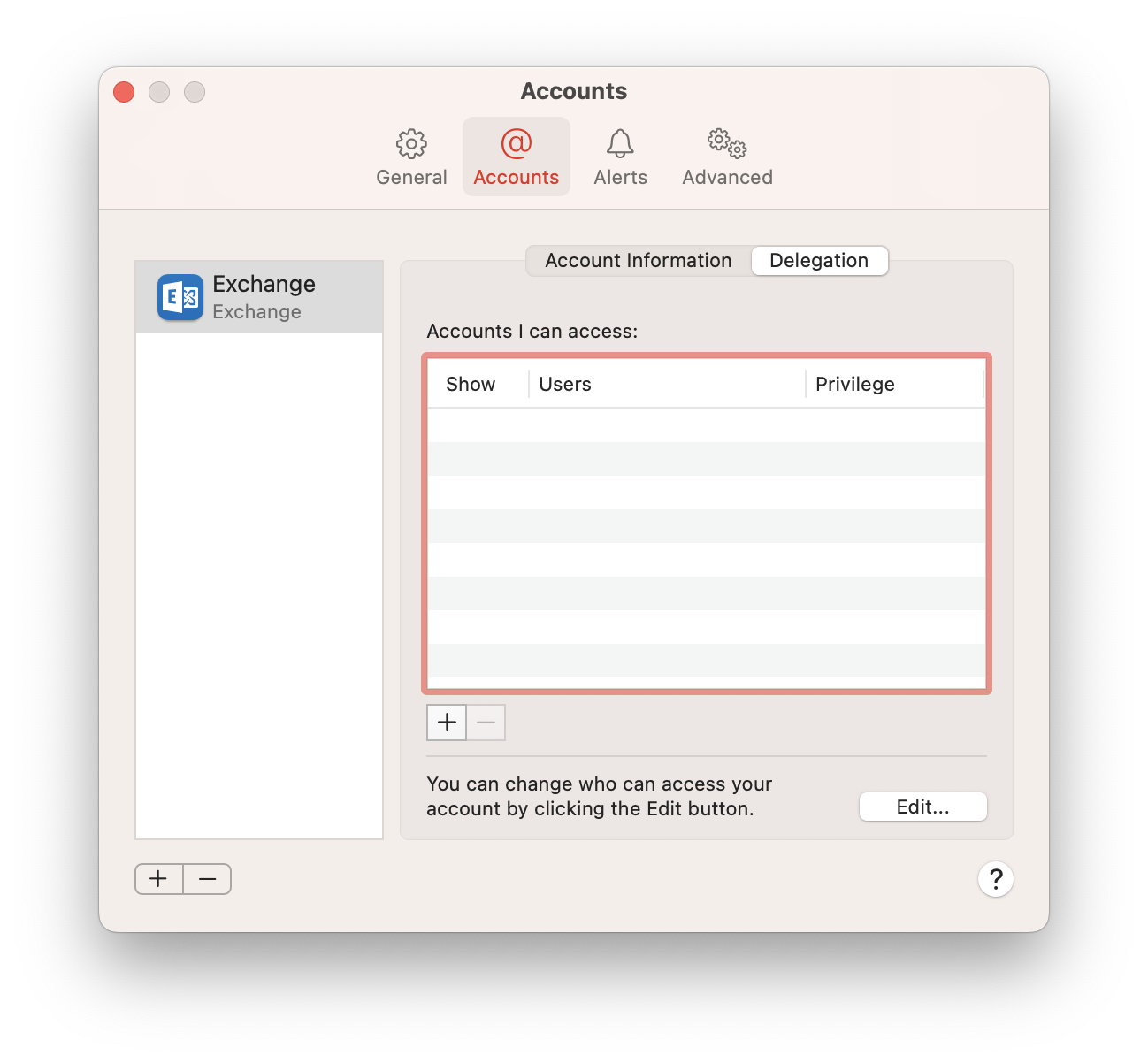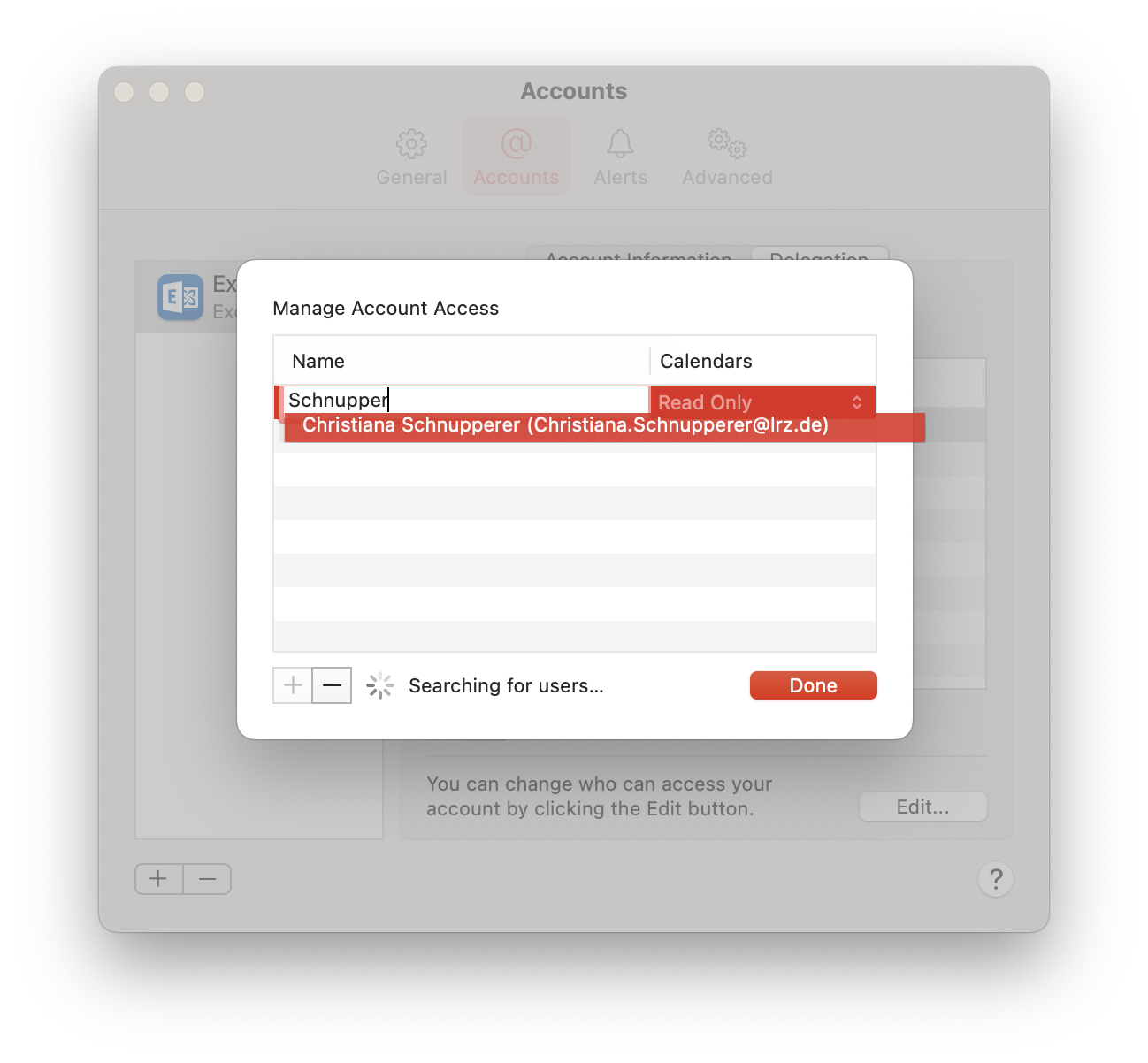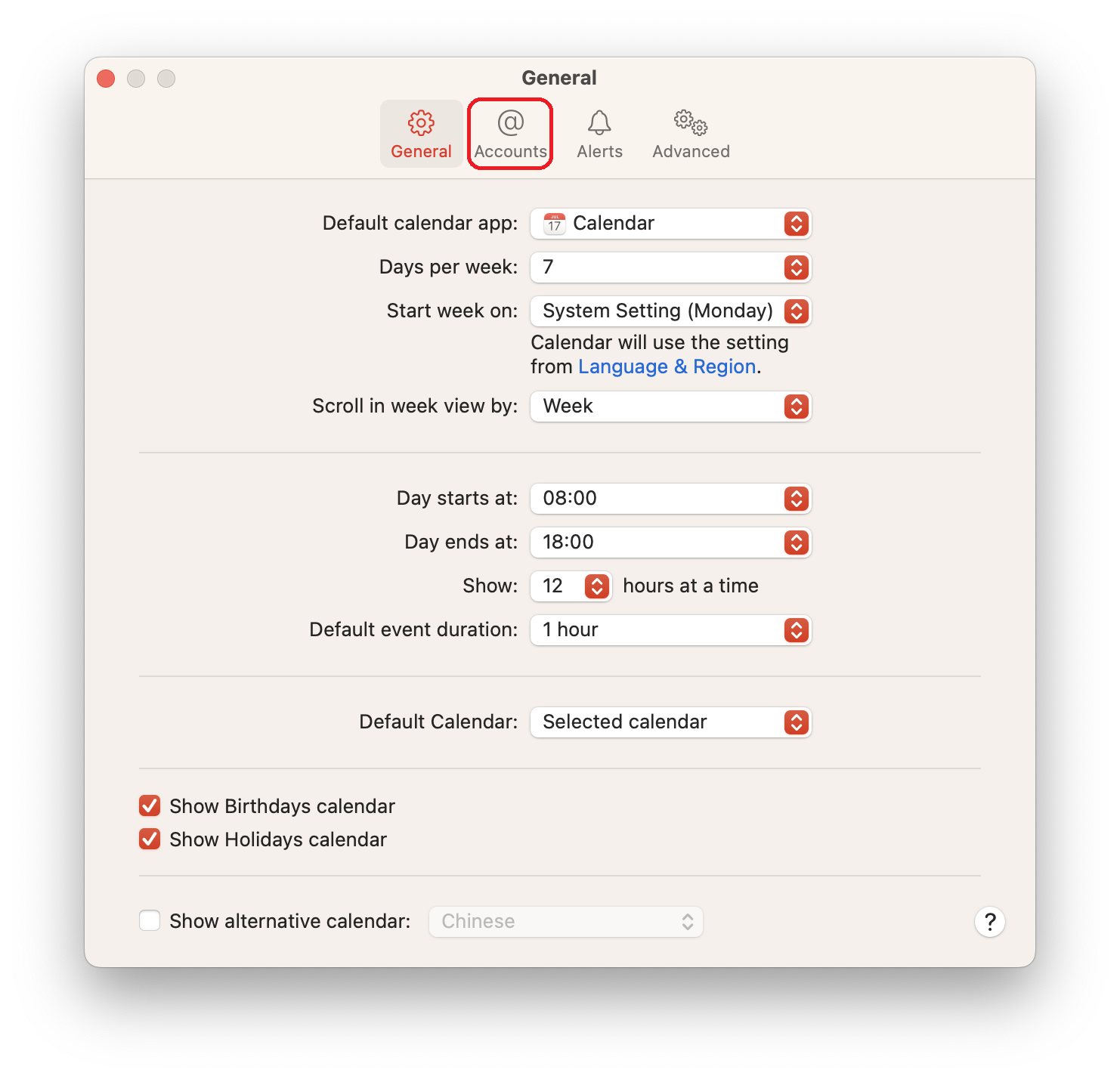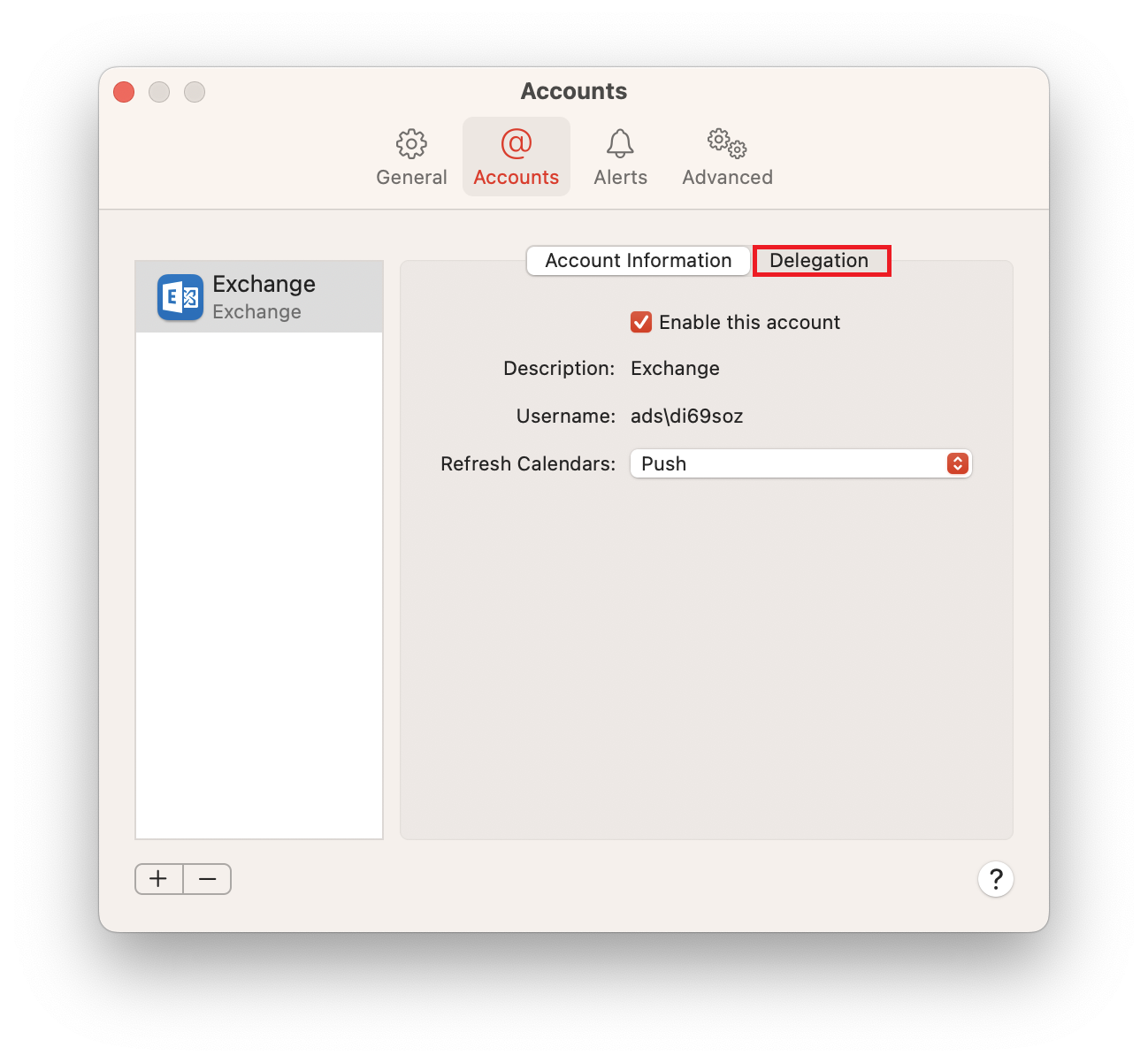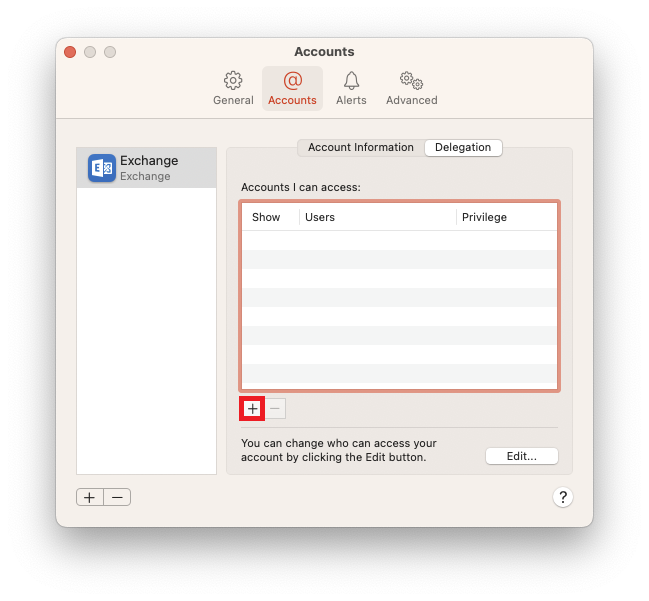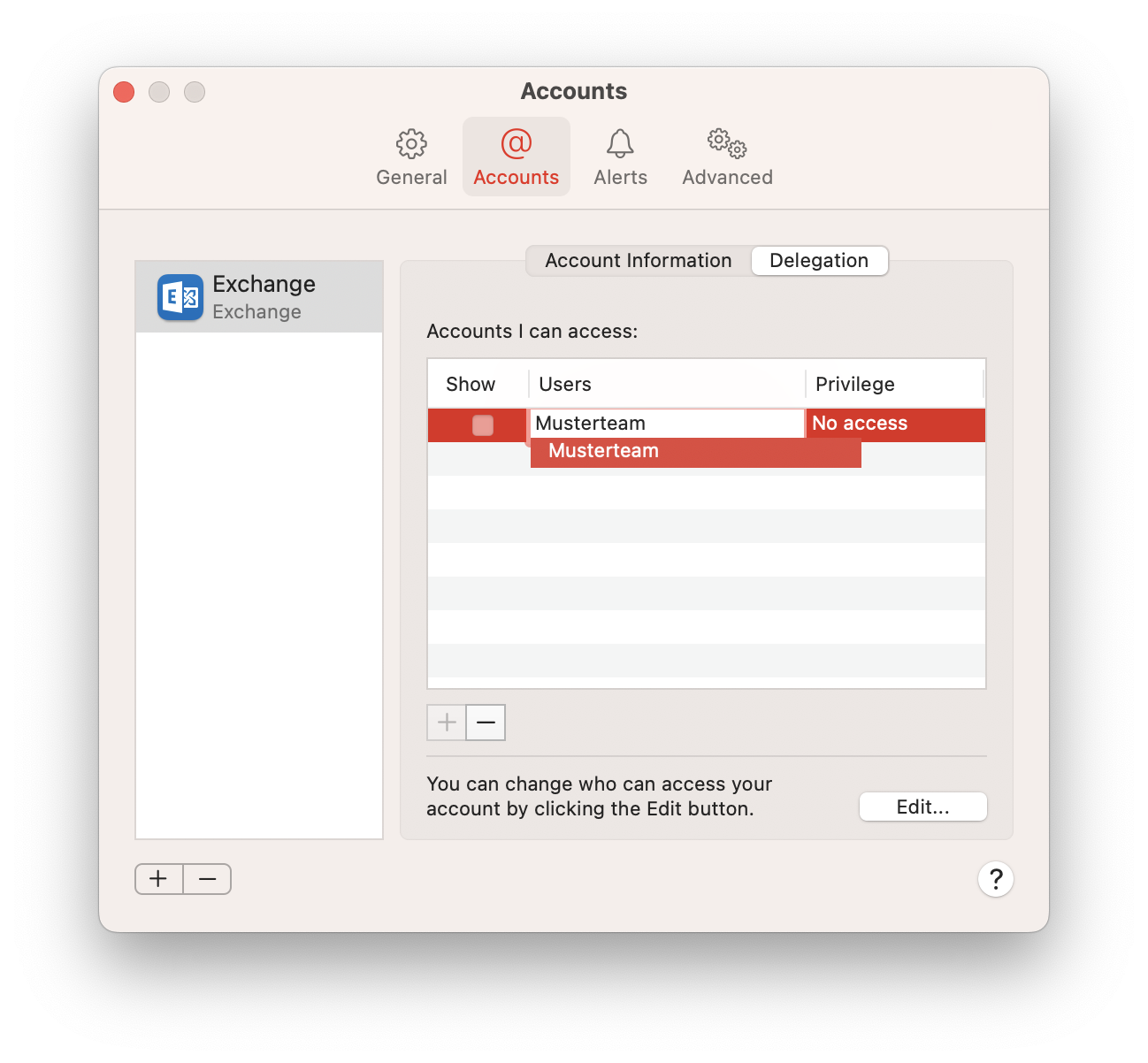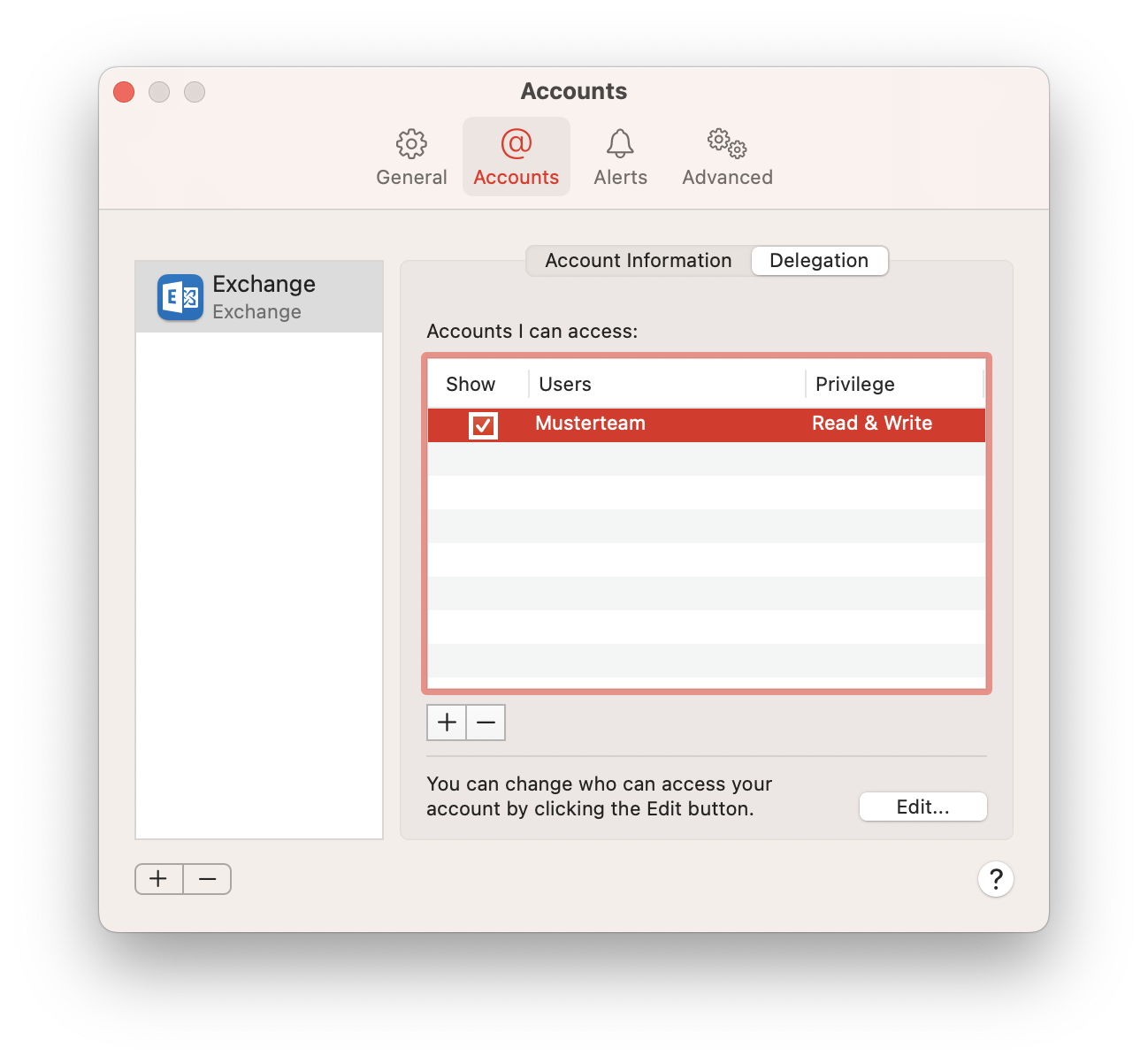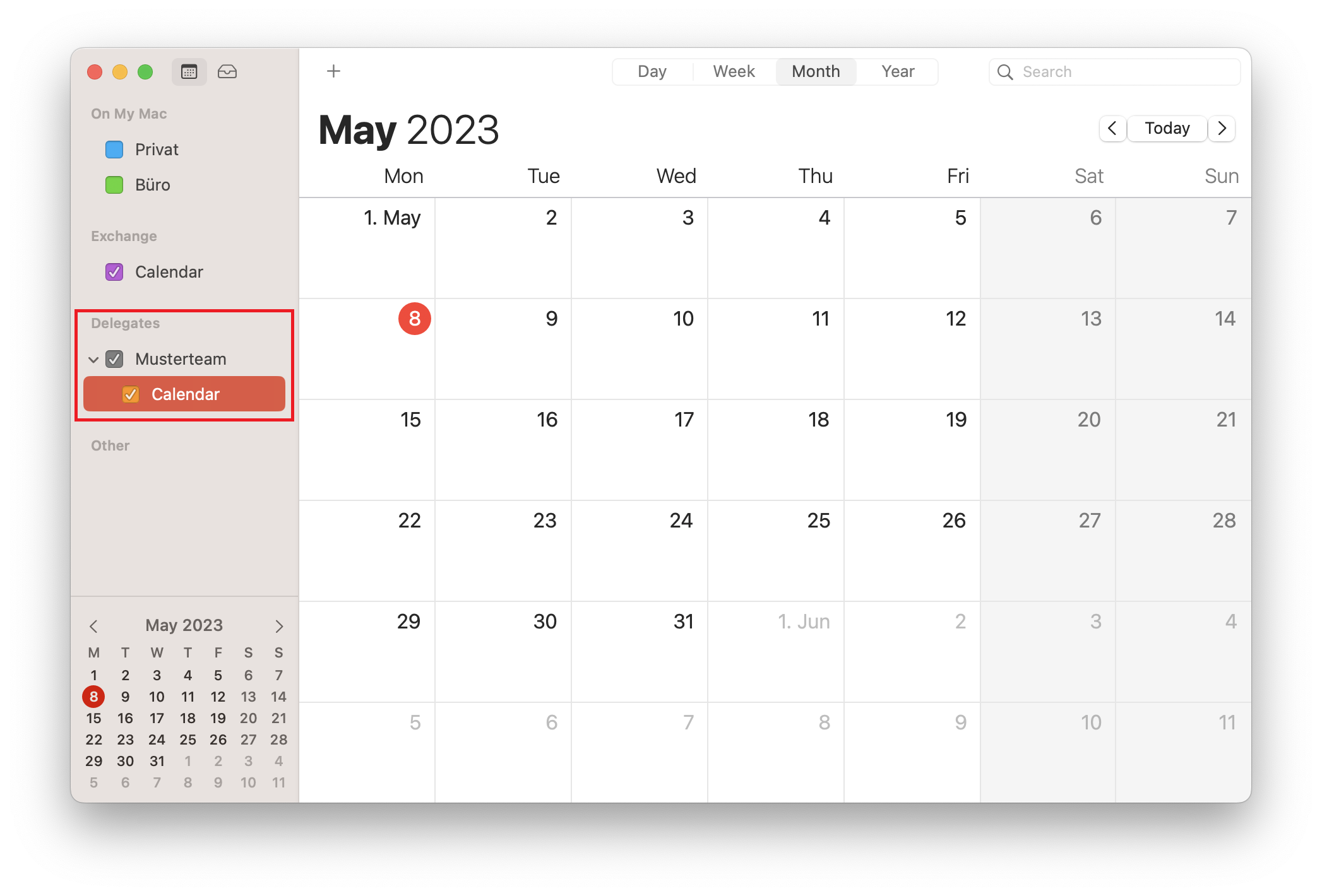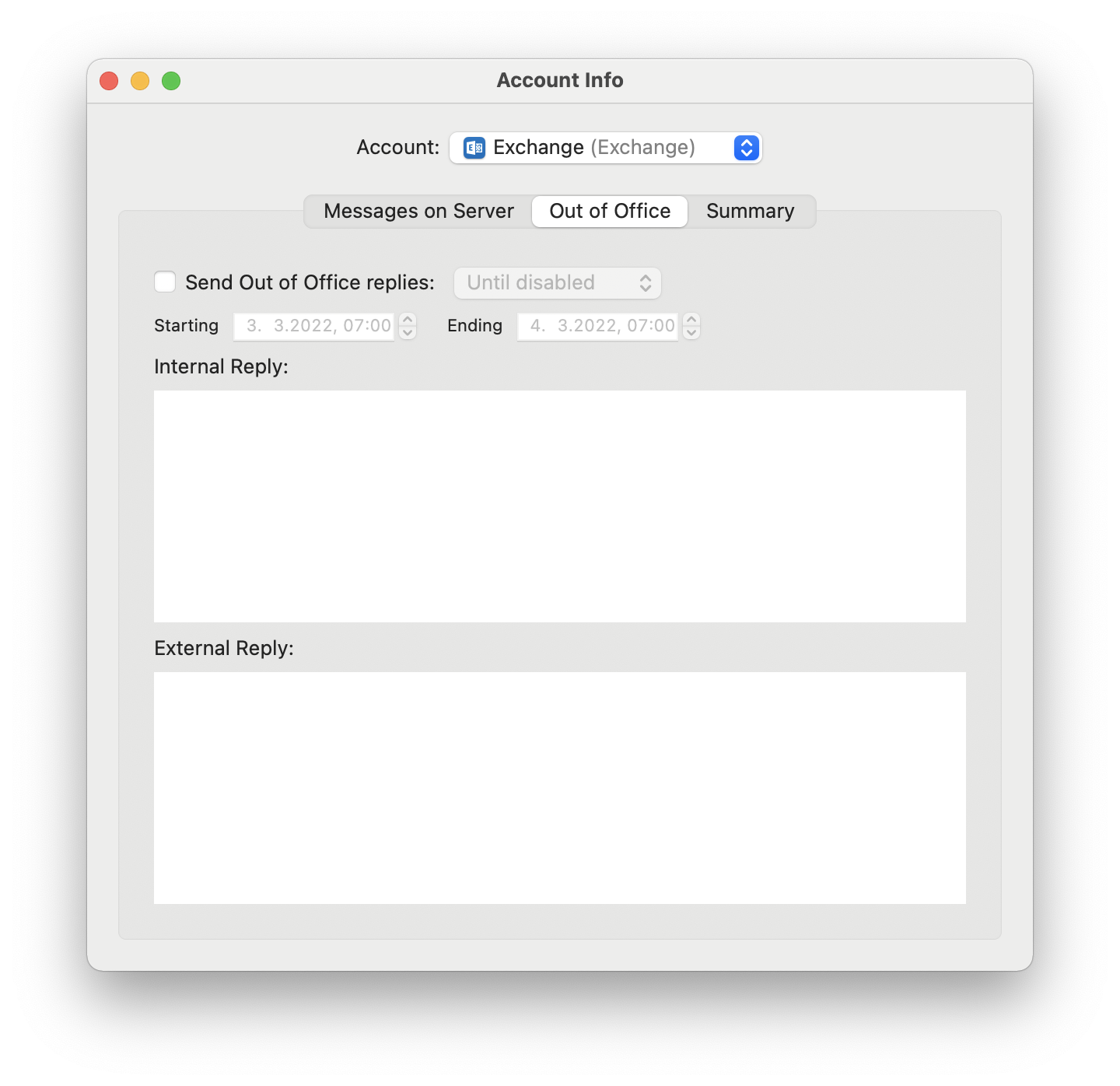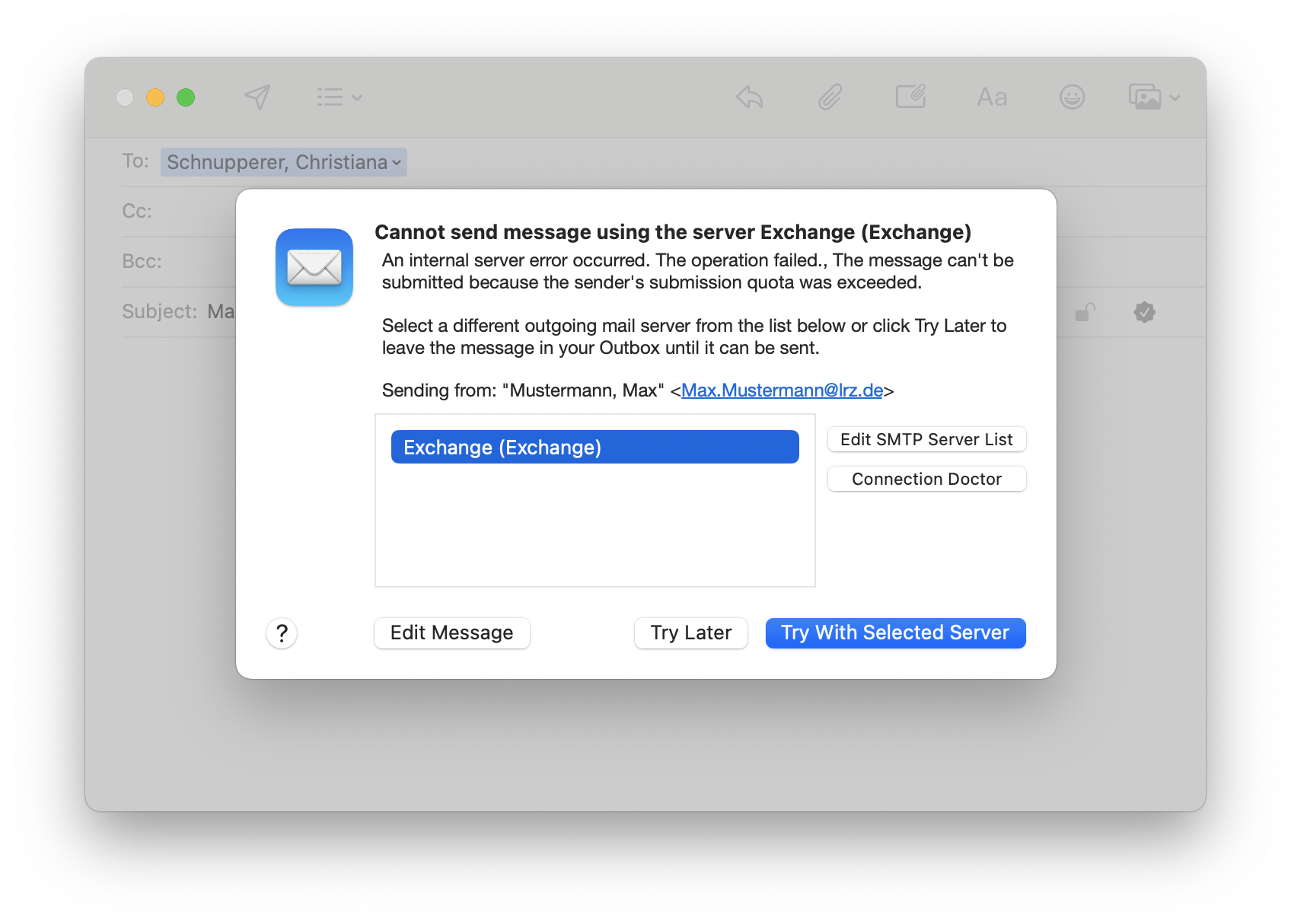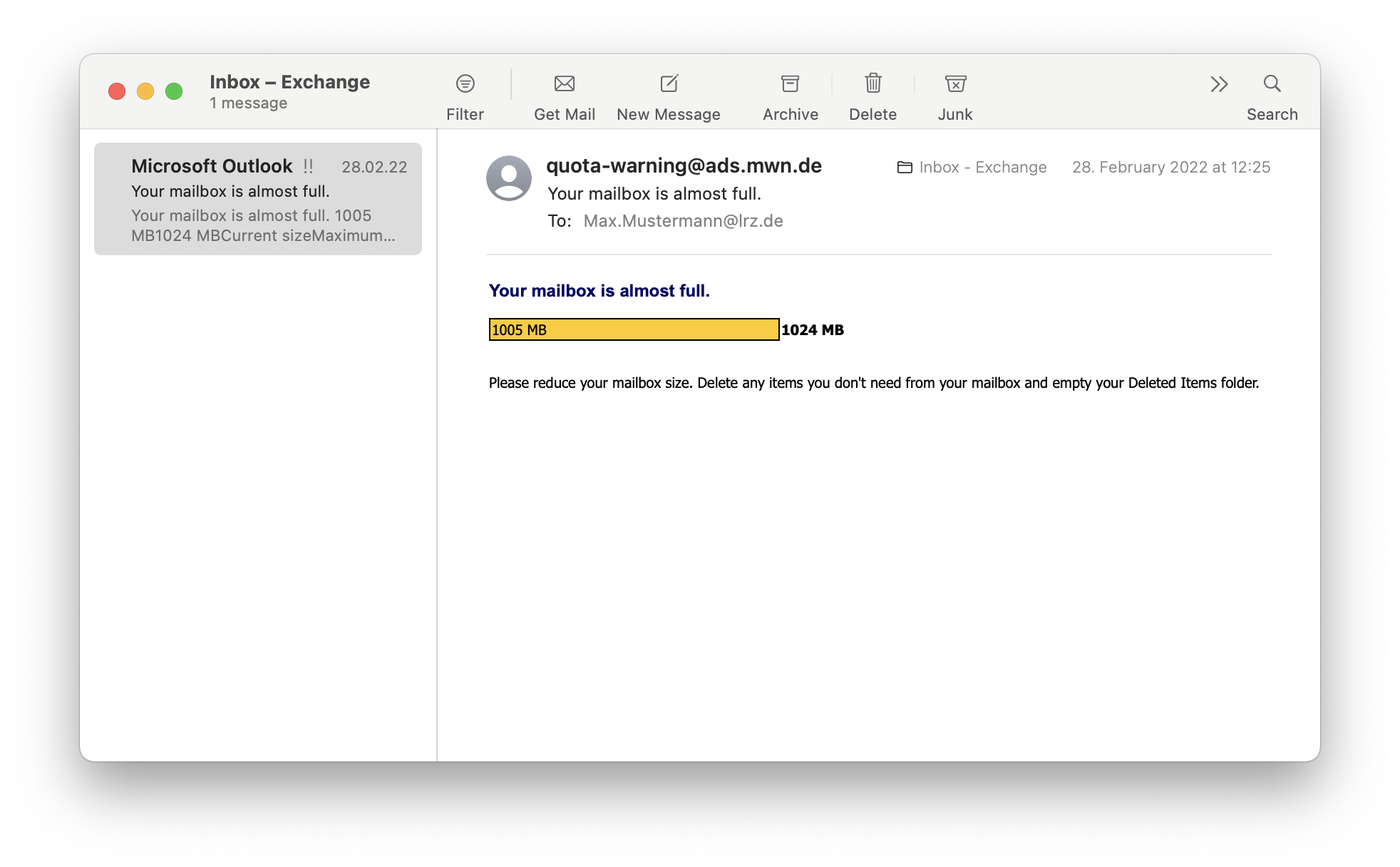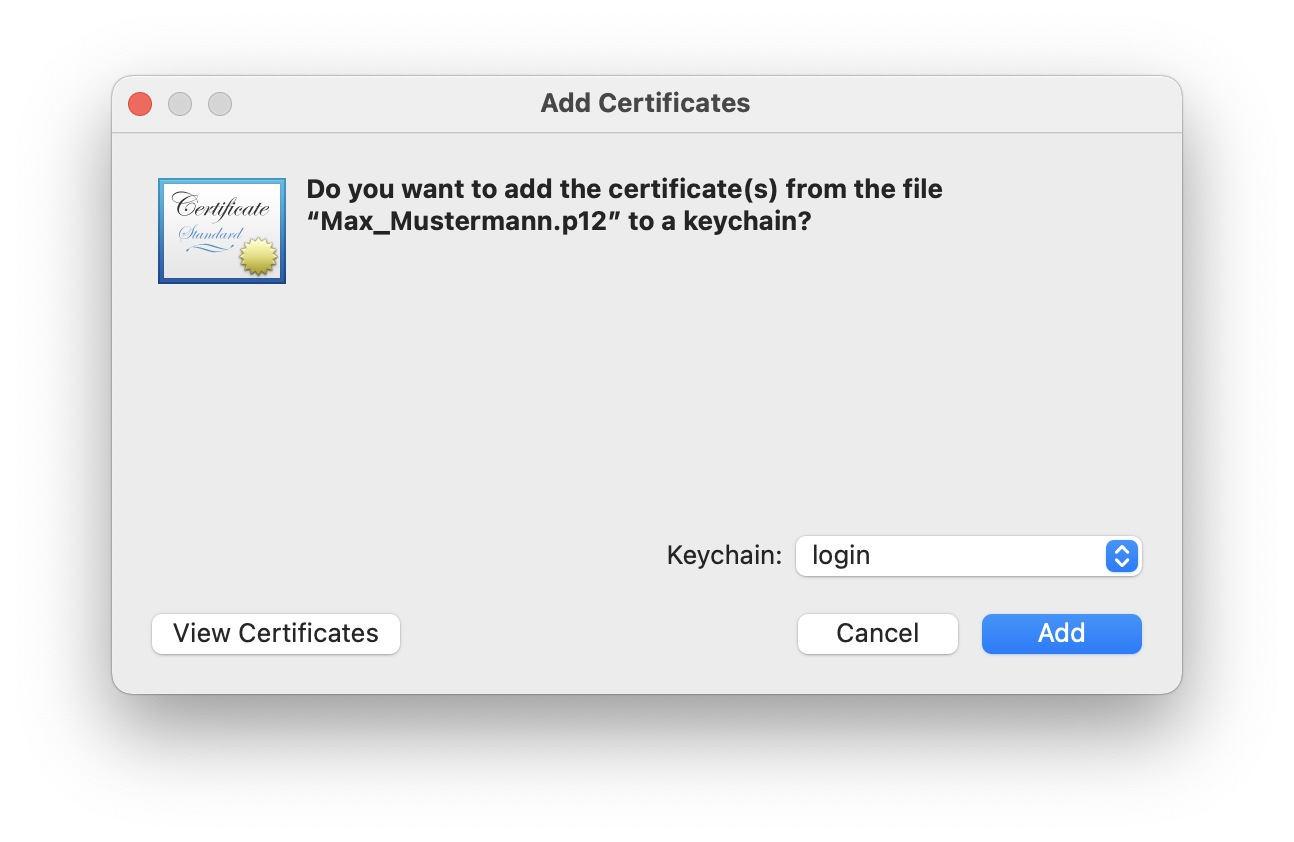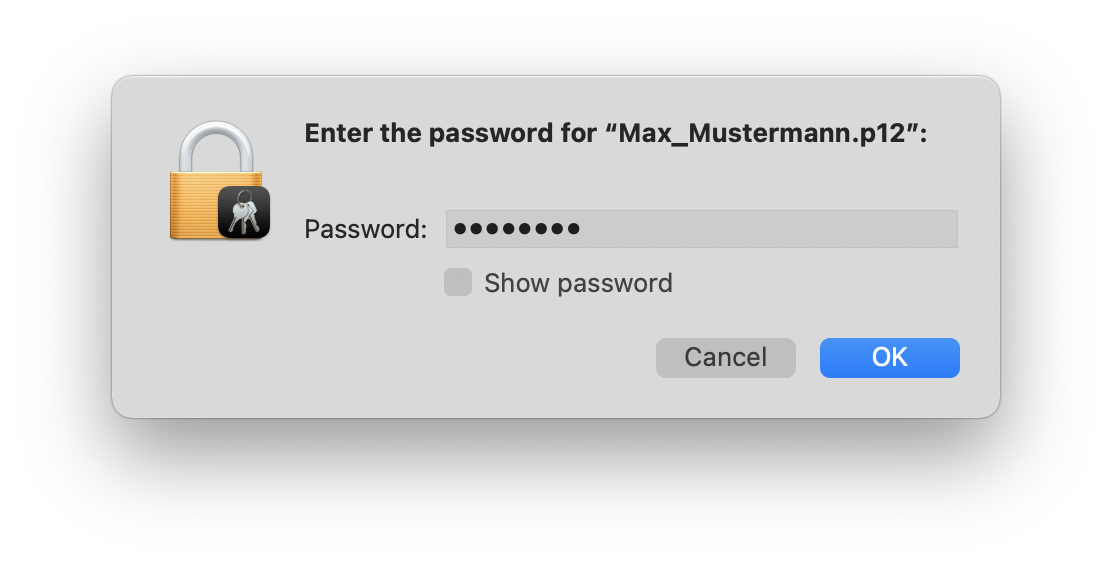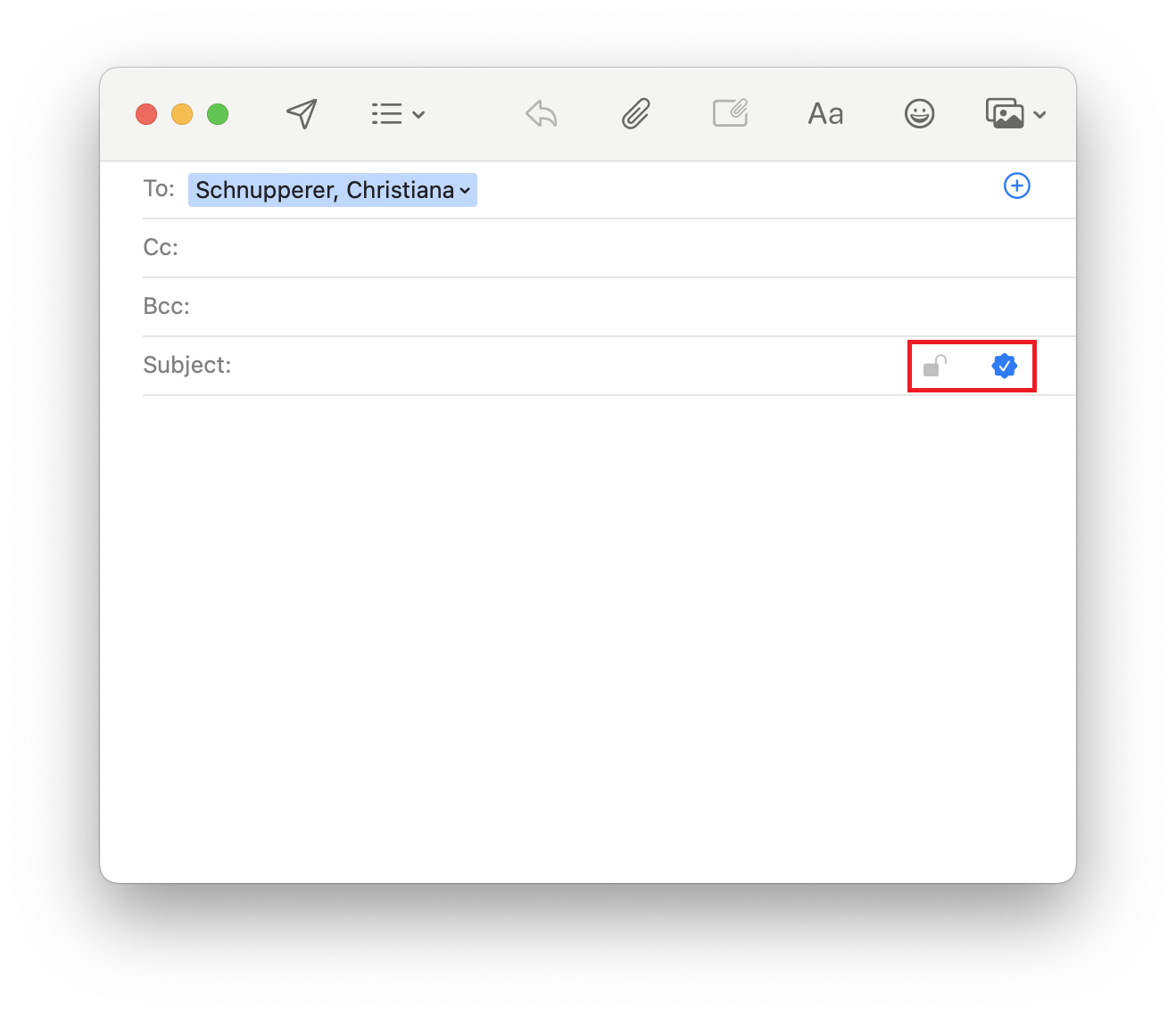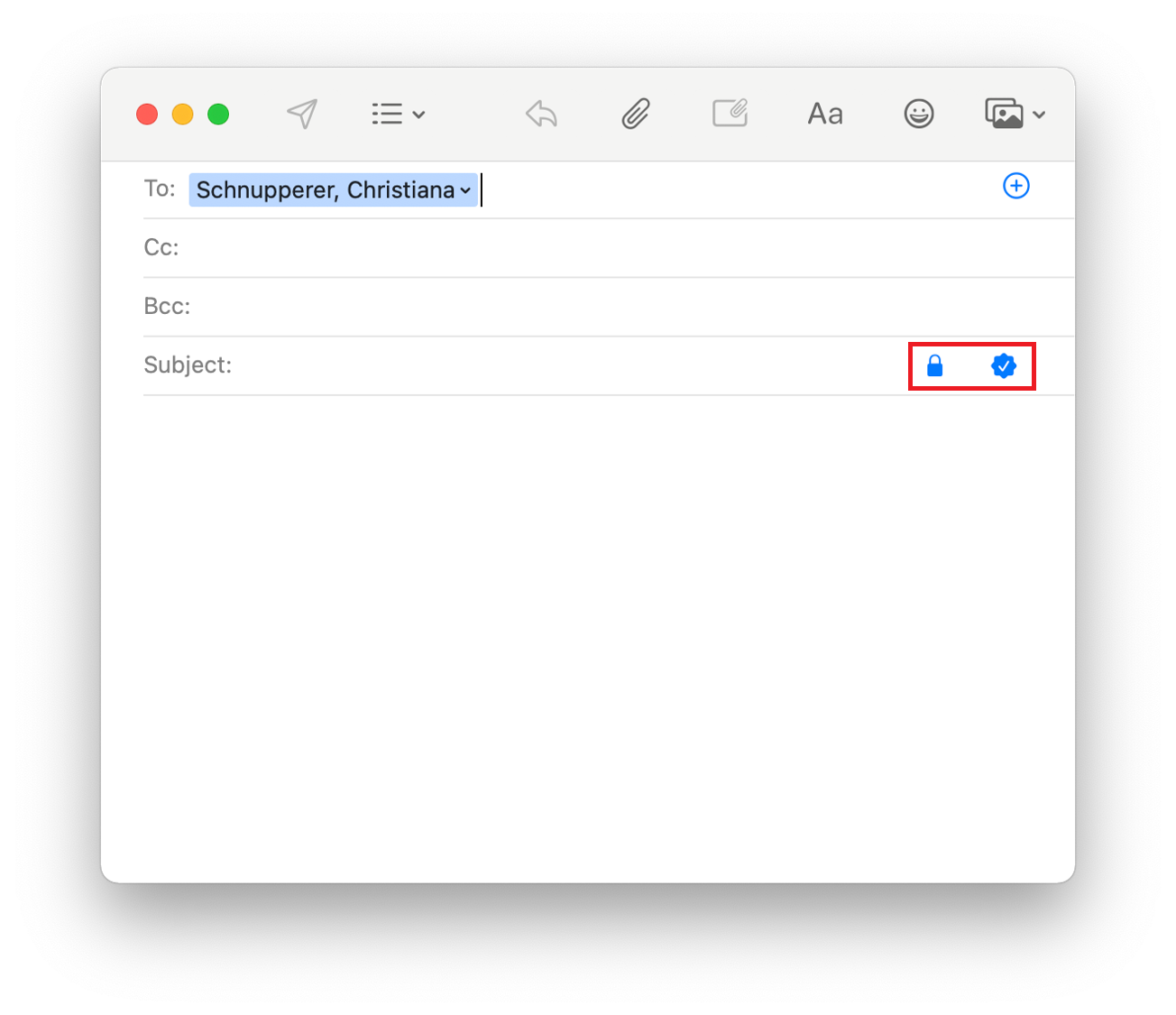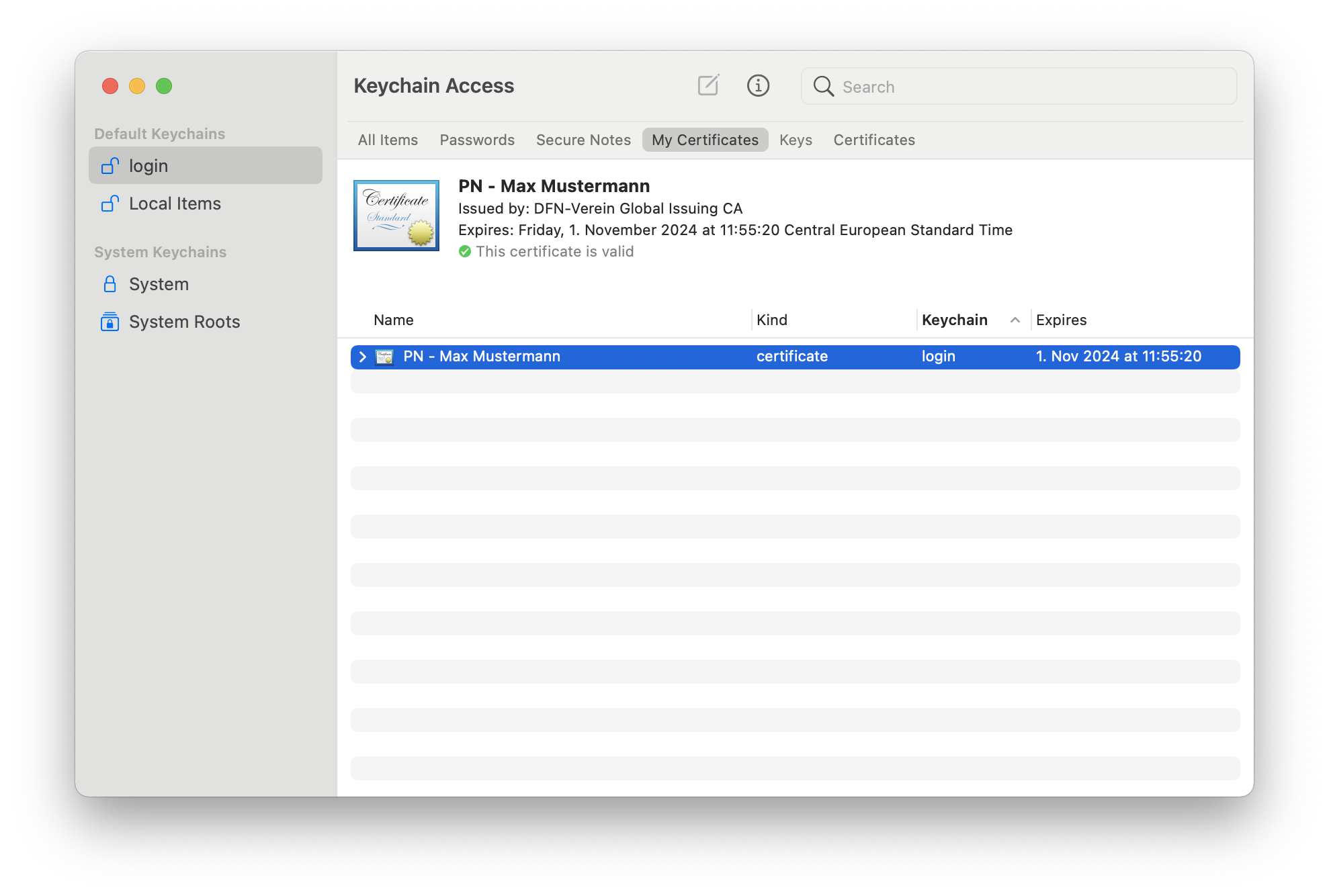Apple Mail (Exchange)
Barrier-free
This page contains alternative texts for images/graphics.
Setup
Open the System Preferences and select "Internet Accounts". When you type or start typing Exchange at the top left of Search, it will be highlighted.
Select Microsoft Exchange from the list.
In the next step, enter your name and Email Address.
After you click Log In, you will be asked if you want your email to be sent to Microsoft to find your account information. This is not necessary because the account information cannot be found there.
Instead, click on "Configure manually".
Now enter your password. The dialogue should look like this:
Enter your user name together with the domain "ads" in the form "ads\account", in the example of Max Mustermann "ads\di69soz".
You must also enter "xmail.mwn.de" as the Internal and External URL.
Shared Mailbox
Shared mailboxes offer the possibility to collaboratively edit a mailbox. Application scenarios include function addresses (such as info@domain.de), shared chair calendars (e.g. for vacation planning), or shared contacts of the chair that everyone is allowed to read or that several people manage together.
The problem with Apple Mail when configuring the shared mailbox is that you cannot specify the correct outgoing mail server right away, because Apple Mail tries to log on to the outgoing mail server with the specified user name. However, in the form that must be used for shared mailboxes, it is impossible to log on to "postout.lrz.de". For this reason, you must first specify a different server and later change to the correct server ("postout.lrz.de").
Open the System Preferences and select Internet Accounts. To add an account, click on "Add Account...".
Since the shared mailbox in Apple Mail cannot be included like a normal Exchange mailbox due to the form in which the user name must be specified, you must expand the selection via "Add other account ..." and then select "Mail account".
In the next step you will be asked for the email address and password. Enter the shared mailbox email address and your own password. The attempt to retrieve the settings automatically will fail. Only the second time you will be asked for the username. The username must be entered in the following form:
Example: Your account is "di69soz" and the shared mailbox account is "di69kim". The correct username is then "ads\di69soz\di69kim".
When the setup has worked, you can select whether you want to have only the emails or also your notes synchronized. If the mailbox is set up to receive emails, you need to change the outgoing mail server.
To do this, you need to go to the Mail App settings and switch to Accounts. Now click on the IMAP account you just set up and then switch to the Server settings tab.
Here you have to change the hostname at Outgoing Mail Server to "postout.lrz.de" as well as the Username from "ads\<your account>\<shared mailbox acount>" to your account. In addition, uncheck "Automatically manage connection settings" and select "Password" as the method for authentication.
Calendar
If you want to add a calendar of a shared Mailbox or a shared calendar to the Calendar app or share your own calendar with others, open the Calendar settings.
Go to Calendar in the menu bar and then select "Preferences...". The keyboard shortcut is Command-Comma.
From the "General" tab, switch to "Accounts" and then from "Account information" to "Delegation".
In the Apple Calendar app on the Mac, it is possible to include the calendar of a shared mailbox or shared calendars. However, to do this, you must first set up the delegate permission.
Share calendars
To share your calendar, click on "Edit..." at the bottom right of the Delegation in the calendar preferences.
A window will open. Click there on the small plus and then search in the appeared line for the person who should receive the access.
Once you have selected the user, you can still adjust the permissions. To do this, click on "Read only" in the Calendar column. The following menu opens, from which you select the permission level to be assigned.
Click "Done" to complete the sharing process.
Open shared calendar
Unfortunately, it is not possible to display the free/busy times of other calendars in the Apple calendar. To open a foreign calendar, you need at least read permissions.
Once you've set up this permission, to set up the calendar, open the Calendar app's Preferences. There, switch to Accounts and then select the "Delegation" tab.
To add it, click the plus. Then, when you start entering the account or the email, you will see suggestions. Select the desired mailbox from them, otherwise it will not work.
In order for the calendar to be displayed, the "Show" checkbox must be checked.
Notes
Filter rules
Filter rules that you create in Apple Mail are not transferred to the Exchange Server. We therefore recommend that you create filter rules in Outlook on the Web.
How do I set up an Out of Office message?
Make a right click on "Inbox". If you have multiple mailboxes, right-click on the email address below the Inbox. Then select "Account info". Now switch to "Out of Office".
You can configure different out of office messages for senders inside (all on the Exchange Server) and outside the setup.
By the way, your out-of-office message will not be triggered by mail from mailing lists or mail marked as spam.
Typical error messages
Why can't I send emails anymore?
If you have sent a lot of emails or emails with a high number of recipients in one day, it is possible that you cannot send any more emails and when you try to send another email, the adjacent message pops up.
The reason is that you have exceeded the limit of 250 recipients within 24 hours. The limit resets automatically after 24 hours.
The purpose of the limit is to ensure that only a limited number of emails are sent, even via compromised accounts. This keeps the risk of LRZ mail servers getting onto so-called "denylists" as small as possible.
Full mailbox
Your mailbox has a certain size (usually 5 GiB). If you exceed it, you will not be able to send or receive emails.
When you get to the limit, you will first receive a warning mail (From: Microsoft Outlook - quota-warning@ads.mwn.de). If the memory consumption continues to increase, you will no longer be able to send messages. If the quota is significantly exceeded, you will also no longer be able to receive messages.
If you have reached the limit for sending, the following message will pop up when you try to send, indicating that you have exceeded the mailbox quota.
You can see the current size of your mailbox by right-clicking on "Inbox". If you have several mailboxes, right-click on the email address below the Inbox. Then select "Account Info". There you will also see the sizes of the individual folders. Unfortunately, you cannot see here what quota you have (how large your mailbox may become), nor what percentage of your mailbox is occupied. But you can check this in Outlook on the Web.
Encrypt and sign
In order to send e-mails signed or encrypted with S/MIME using Outlook, you need a personal user certificate.
As a member of TUM, you can find information on how to apply for a certificate at https://www.it.tum.de/en/it/certificates/. If you have any difficulties in doing so, please contact the IT support of TUM (it-support@tum.de).
For the other institutions of the MWN, we are currently not aware of any way to obtain a personal user certificate.
Please pay attention to the correct format when downloading your certificate. Unfortunately, some operating systems (e.g. Windows, MacOS) only support TripleDES-SHA1.
For further information, please visit https://doku.tid.dfn.de/de:dfnpki:tcs:usercert#auswahl_des_key_protection_algorithms_in_formularen_fuer_p12-dateien.
Please note that the encryption method with S/MIME described here is not compatible with the PGP method which is especially widespread under Unix/Linux. PGP is not supported by Outlook and Outlook on the Web.
Briefly, the essential properties of signed and encrypted e-mails:
- Signing an e-mail ensures that it cannot be manipulated unnoticed on its way from the sender to the recipient. Whether the e-mail is transmitted in encrypted form depends on whether the mail systems involved support transport encryption.
- By encrypting an e-mail, the content is already encrypted before it is sent and is therefore transmitted in encrypted form (and also stored in the mailbox in encrypted form) regardless of the properties of the mail systems involved. When working with encryption, it is essential to keep your own certificate (especially the private key) in a loss-proof manner, as otherwise encrypted e-mails can no longer be read - neither those you have encrypted yourself nor those you have received.
General preparations
Before you can sign or encrypt e-mails, you have to import your user certificate on your computer. If you want to send digitally signed or encrypted e-mails from multiple computers, you must import the certificate on each of these computers. This also applies if you want to read encrypted emails on multiple PCs.
By double-clicking on your certificate file (file with extension ".p12" or ".pfx" ), a certificate import wizard opens. The keyring management opens automatically with the question whether the certificate should be added. There you select (if not already preselected) the item "login" from the drop-down list and click on "Add".
A new window opens asking you to enter a password. This password was set by you before you exported the certificate and its private key to the P12 file.
Sign emails digitally with S/MIME
To add a digital signature to an email, you don't have to do anything else in Apple Mail after you add the certificate. Apple Mail itself looks in the keychain to see if a certificate is available for the email address. If a suitable one was found, all emails will be signed automatically.
If you do not want the email to be signed, click on the blue button. If it is gray, the email will be sent unsigned.
Encrypting emails with S/MIME
The same applies to encryption as to signing. The only difference to signing is, you need not only your own certificate, but also the certificate (more precisely: the public key) of the recipient. If you have both keys, the email will be automatically encrypted and signed. How to get a public key is described below.
How do I get the public certificate of a recipient?
To send encrypted emails you always need the certificate of the recipient. If you don't have it, there are several ways you can possibly find the certificate:
A digitally signed or encrypted email from the recipient.
If you have already received a digitally signed or encrypted email from the recipient, the public certificate was also sent to you in this email. As soon as you have opened this email, Apple Mail saves the certificate in your keychain and you can send encrypted emails to this recipient.
Where can I see which certificates I have stored?
Open the keychain management and select the keychain "Login". In the field at the bottom left, you can then set the filter to "Certificates".





